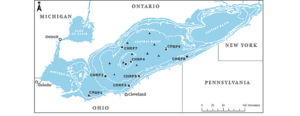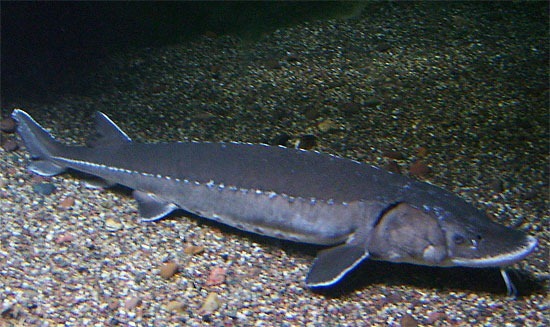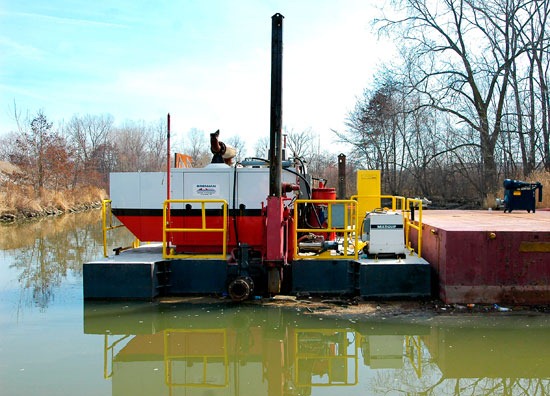Research Brief: Hypoxia and Anoxia in Lake Erie’s Central Basin
0While the western basin of Lake Erie is known for its annual blooms, the central basin has been experiencing periods of hypoxia and anoxia for decades. Low dissolved oxygen (DO) conditions can influence other water quality parameters, water treatment strategies, and habitat suitability for native species.

Port Colborne Ontario, Canada. View of Lake Erie at Sunset (Credit: Onasill – Bill Badzo via Flickr CC BY-NC-SA 2.0)
While hypoxia has been reported in the central basin since the 1950s, most research has focused on the deeper parts of the basin, which has occurred relatively infrequently. In order to better understand DO concentrations and dynamics throughout the water column, more detailed monitoring must be conducted.
A 2023 study published in the Journal of Great Lakes Research deployed a network of moorings throughout the basin to monitor DO at various depths. Due to the connection between temperature and DO, thermal data was also collected as a way of recording the thermal structure of the basin.
Simultaneous research of the two parameters allows for connections to be made between certain thermal structures and periods of hypoxia. An improved understanding of what causes and extends hypoxic conditions promotes model upgrades and supports better resource management.
Methods
Moorings were deployed at eight sites around Lake Erie’s central basin from approximately May through September in 2017-2019.1 Sensors were attached to the moorings at different lengths (depending on the depth of the site) that logged temperature and DO at 10-minute intervals.
Generally, temperature sensors were dispersed evenly on the mooring from the top to the bottom, with DO sensors located more frequently only at the bottom of the mooring. Due to the central basin experiencing heavy boat traffic, surface data was collected via satellite rather than sensors to avoid damage and data loss.
Temperature was recorded using SeaBird Scientific SBE 56 sensors and RBR Ltd Solo sensors, and DO was recorded using PME miniDOTs. Each site was also equipped with two Onset U20L-02 pressure sensors to determine vertical movement of the sensor line during deployment. A YSI EXO sonde was attached to the mooring of sites 2 and 9.
Results
Due to the different depths and locations in the basin, each site experienced variance in hypoxic period duration and severity, with some sites experiencing anoxia. Complete summaries of data from the sites can be found in the full article. Sites 1, 3, 5, and 8 were in the shallower parts of the basin, while sites 2, 4, 7, and 9 were in the deeper portion.

Lake Erie map depicting mooring locations. Black triangles denote US EPA hypoxia monitoring sites. (Stow et al., 2023)
Stratification typically occurred by late May or early June and continued until the moorings were removed in late September/early October. Hypoxia onset typically started in the western, nearshore sites (1, 3, and 5) and showed a general west-east progression in deeper sites (2, 4, 7, and 9).1 While hypoxia generally first occurred in shallower sites, Sites 2, 4, and 9—which were the deepest sites—experienced more persistent hypoxia once it occurred, often leading to anoxia.
Thermal stratification did not follow the same west-east progression seen in the onset of hypoxia, suggesting that DO consumption may vary spatially throughout the central basin. The study also highlights the role of weather, nutrient pollution and other variables that can influence DO consumption outside of strictly temperature dynamics.
Due to limited data from the shallower sites on the eastern side of the basin and variables outside of temperature, the study concludes that a more extensive network is necessary to track the spread of hypoxia in the central basin of Lake Erie.
Source
- Stow, Craig & Rowe, M. & Godwin, Casey & Mason, Lacey & Alsip, Peter & Kraus, Richard & Johengen, Thomas & Constant, Stephen. (2023). Lake Erie hypoxia spatial and temporal dynamics present challenges for assessing progress toward water quality goals. Journal of Great Lakes Research. 49. 10.1016/j.jglr.2023.02.008.













